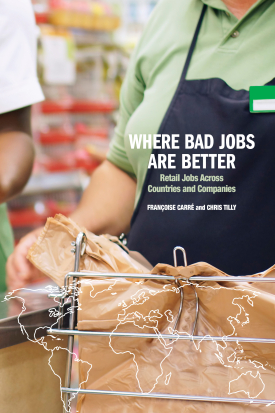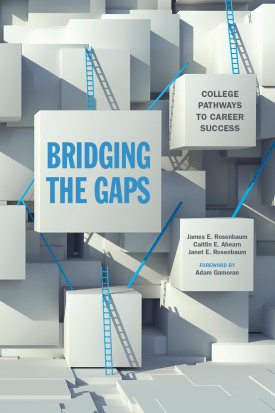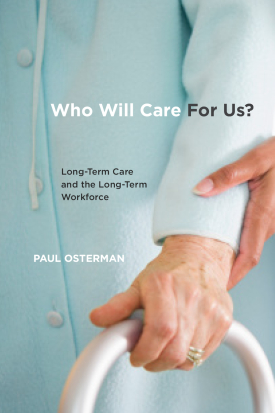About This Book
A paper from the Playground Association of America calling for a play organizer position for children's play.
HOWARD BRADSTREET was a member of the Playground Association of America.
A paper from the Playground Association of America calling for a play organizer position for children's play.
HOWARD BRADSTREET was a member of the Playground Association of America.

Winner of the 2019 Outstanding Book Award from the Inequality, Poverty, and Mobility Section of the American Sociological Association
2018 Choice Outstanding Academic Title
“Bruce Western, our foremost authority on mass incarceration, has filled in a yawning gap in the research on one of the great banes of our era. Homeward is a thorough and deeply illuminating study on the end-point of mass incarceration—the effort to reintegrate ex-offenders into our society. The challenges outlined in the book should not simply inform our reentry efforts, but should also make us question the American policy of handing down sentences, which, in some profound way, never really end.”
—Ta-Nehisi Coates, National Correspondent, The Atlantic
“In Homeward, Bruce Western probes in rich detail the lives of ex-prisoners in their first year of life back on the streets of Boston. He looks unflinchingly at the correlated web of adversities that men and women face in the transition out of prison, especially how violence, drug and alcohol addiction, mental illness, and family chaos exacerbate the stigma of a prison record in the reentry to society. Beautifully written and deeply researched, this book provides an important framework on social and criminal justice. The implications for policy are profound.”
—Robert J. Sampson, Henry Ford II Professor of the Social Sciences, Harvard University
In the era of mass incarceration, over 600,000 people are released from federal or state prison each year, with many returning to chaotic living environments rife with violence. In these circumstances, how do former prisoners navigate reentering society? In Homeward, sociologist Bruce Western examines the tumultuous first year after release from prison. Drawing from in-depth interviews with over one hundred individuals, he describes the lives of the formerly incarcerated and demonstrates how poverty, racial inequality, and failures of social support trap many in a cycle of vulnerability despite their efforts to rejoin society.
Western and his research team conducted comprehensive interviews with men and women released from the Massachusetts state prison system who returned to neighborhoods around Boston. Western finds that for most, leaving prison is associated with acute material hardship. In the first year after prison, most respondents could not afford their own housing and relied on family support and government programs, with half living in deep poverty. Many struggled with chronic pain, mental illnesses, or addiction—the most important predictor of recidivism. Most respondents were also unemployed. Some older white men found union jobs in the construction industry through their social networks, but many others, particularly those who were black or Latino, were unable to obtain full-time work due to few social connections to good jobs, discrimination, and lack of credentials. Violence was common in their lives, and often preceded their incarceration. In contrast to the stereotype of tough criminals preying upon helpless citizens, Western shows that many former prisoners were themselves subject to lifetimes of violence and abuse and encountered more violence after leaving prison, blurring the line between victims and perpetrators.
Western concludes that boosting the social integration of former prisoners is key to both ameliorating deep disadvantage and strengthening public safety. He advocates policies that increase assistance to those in their first year after prison, including guaranteed housing and health care, drug treatment, and transitional employment. By foregrounding the stories of people struggling against the odds to exit the criminal justice system, Homeward shows how overhauling the process of prisoner reentry and rethinking the foundations of justice policy could address the harms of mass incarceration.
BRUCE WESTERN is the Daniel and Florence Guggenheim Professor of Criminal Justice Policy and Professor of Sociology at Harvard University, and Co-Director of the Justice Lab at Columbia University.

Winner of the 2019 Distinguished Scholarly Monograph Award Presented by the Labor and Labor Movements Section of the American Sociological Association
Winner of the 2018 William G. Bowen Award Presented by the Industrial and Labor Relations Section of Princeton University
“If you think declining job quality is an inevitable outcome of globalization, computerization, or financialization, think again. Where Bad Jobs Are Better systematically dismantles doom and gloom arguments to offer an empirically-based account of how reasonable reforms to U.S. employment and labor law could help ensure that hourly retail jobs are at least pretty darn good. Françoise Carré and Chris Tilly show how institutional structures, social norms, and worker voice combine to create meaningful variation in the quality of seemingly similar retail jobs. No book on the retail sector approaches either the insights or the comprehensiveness as that offered by Where Bad Jobs Are Better.”
—Susan Lambert, associate professor, School of Social Service Administration and codirector, Employment Instability Researchers Network, University of Chicago
“This richly comparative book decisively punctures the myth that retail jobs are inherently bad jobs. By comparing two retail sectors in the United States and retail jobs in seven countries, Françoise Carré and Chris Tilly show how institutions shape the quality of retail jobs and point to ways that bad jobs in retail and other service sectors can be upgraded.”
—Arne L. Kalleberg, Kenan Distinguished Professor of Sociology, University of North Carolina at Chapel Hill
“Retail is the largest employment sector in the United States—and Françoise Carré and Chris Tilly offer the most comprehensive and thorough analysis of the management and employment practices in retail that we have. Based on ten years of careful field studies coupled with national data, they explain how the industry has evolved, why so many retail jobs are ‘bad,’ and why this is not inevitable. Their rich descriptions of working conditions across many retail sectors and countries show the negative effects of bad jobs on working families, and show that employers have a choice in their business and labor strategies. By tracing Wal-Mart across several countries, they show how the same employer can behave differently in different environments. Timely, accessible, engaging, important—Carré and Tilly speak to a broad audience of academics, practitioners, and policymakers—providing key insights on how to turn bad jobs into good ones.”
—Rosemary Batt, Alice Hanson Cook Professor of Women and Work and chair, Department of Human Resource Studies, ILR School, Cornell University
Retail is now the largest employer in the United States. For the most part, retail jobs are “bad jobs” characterized by low wages, unpredictable work schedules, and few opportunities for advancement. However, labor experts Françoise Carré and Chris Tilly show that these conditions are not inevitable. In Where Bad Jobs Are Better, they investigate retail work across different industries and seven countries to demonstrate that better retail jobs are not just possible but already exist. By carefully analyzing the factors that lead to more desirable retail jobs, Where Bad Jobs Are Better charts a path to improving job quality for all low-wage jobs.
In surveying retail work across the U.S., Carré and Tilly find that the majority of retail workers receive low pay and nearly half work part-time, which contributes to high turnover and low productivity. Jobs staffed predominantly by women, such as grocery store cashiers, pay even less than retail jobs in male-dominated fields, such as consumer electronics. Yet, when comparing these jobs to similar positions in other countries, Carré and Tilly find surprising differences. In France, though supermarket cashiers perform essentially the same work as cashiers in the U.S., they receive higher pay, are mostly full-time, and experience lower turnover and higher productivity. In Germany, retailers are required by law to provide their employees notice of work schedules six months in advance. And as the authors show in a chapter on Wal-Mart around the world, while the company is notorious for its low-quality jobs in the U.S., in many countries including China and Mexico, Wal-Mart is unionized, pays more than its competitors, or both.
The authors show that disparities in job quality are largely the result of differing social norms and national institutions. For instance, weak labor regulations and the decline of unions in the U.S. have enabled retailers to cut labor costs aggressively in ways that depress wages and discourage full-time work. On the other hand, higher minimum wages, greater government regulation of work schedules, and stronger collective bargaining through unions and works councils have improved the quality of retail jobs in Europe.
As retail and service work continue to expand, American employers and policymakers will have to decide the extent to which these jobs will be good or bad. Where Bad Jobs Are Better shows how stronger rules and regulations can improve the lives of retail workers and boost the quality of low-wage jobs across the board.
FRANÇOISE CARRÉ is research director at the Center for Social Policy at the University of Massachusetts, Boston.
CHRIS TILLY is professor of urban planning at the University of California, Los Angeles.

“Community colleges have long been the neglected stepchild of higher education in America. They are the institutions that absorb millions of less affluent students, who enter college with high ambitions but poor preparation. Bridging the Gaps analyzes the many obstacles to realizing the worthy goals of millions of American students who are tripped up by institutional reliance on test scores, discouraging forms of remedial education, and advising systems that fail to reach the students who need them most. The authors tell us why this is the case and, more importantly, what we have to do to remedy the situation for the good of our young people, mature students, the labor market, and employers who need a skilled workforce. It is a critically important read.”
—Katherine S. Newman, provost, senior vice chancellor for academic affairs, and Torrey Little Professor of Sociology, University of Massachusetts, Amherst
“Bridging the Gaps explodes two myths. The first is that the baccalaureate degree is the only postsecondary degree worth having. The second is that students fail in community colleges primarily for lack of ability or motivation to succeed. Through a series of well-designed studies, the authors show that sub-baccalaureate credentials are valuable in the labor market and for life and work satisfaction. They show that confusing and ineffective placement tests, unclear pathways to degrees, poor advising, and weak career services contribute to the shockingly low completion rates at community colleges. They demonstrate that the correction of these deficiencies is not expensive and would allow community colleges to contribute much more than they currently do to students’ aspirations for upward mobility.”
—Steven Brint, Distinguished Professor of Sociology and Public Policy, University of California, Riverside
College-for-all has become the new American dream. Most high school students today express a desire to attend college, and 90 percent of on-time high school graduates enroll in higher education in the eight years following high school. Yet, degree completion rates remain low for nontraditional students—students who are older, low-income, or have poor academic achievement—even at community colleges that endeavor to serve them. What can colleges do to reduce dropouts? In Bridging the Gaps, education scholars James Rosenbaum, Caitlin Ahearn, and Janet Rosenbaum argue that when institutions focus only on bachelor’s degrees and traditional college procedures, they ignore other pathways to educational and career success. Using multiple longitudinal studies, the authors evaluate the shortcomings and successes of community colleges and investigate how these institutions can promote alternatives to BAs and traditional college procedures to increase graduation rates and improve job payoffs.
The authors find that sub-baccalaureate credentials—associate degrees and college certificates—can improve employment outcomes. Young adults who complete these credentials have higher employment rates, earnings, autonomy, career opportunities, and job satisfaction than those who enroll but do not complete credentials. Sub-BA credentials can be completed at community college in less time than bachelor’s degrees, making them an affordable option for many low-income students.
Bridging the Gaps shows that when community colleges overemphasize bachelor’s degrees, they tend to funnel resources into remedial programs and try to get low-performing students on track for a BA. Yet, remedial programs have inconsistent success rates and can create unrealistic expectations, leading struggling students to drop out before completing any degree. The authors show that colleges can devise procedures that reduce remedial placements and help students discover unseen abilities, attain valued credentials, get good jobs, and progress on degree ladders to higher credentials.
To turn college-for-all into a reality, community college students must be aware of their multiple credential and career options. Bridging the Gaps shows how colleges can create new pathways for nontraditional students to achieve success in their schooling and careers.
JAMES E. ROSENBAUM is professor of sociology, education, and social policy, and research fellow at the Institute for Policy Research at Northwestern University.
CAITLIN AHEARN is a Ph.D. student in sociology at UCLA.
JANET E. ROSENBAUM is assistant professor in the Department of Epidemiology and Biostatistics at the School of Public Health at SUNY Downstate Medical Center in Brooklyn, NY.

“Who Will Care for Us? is a comprehensive and probing work on the challenges and opportunities of building a labor force to do some of the most consequential and sensitive work in our society: providing long-term care for others. Paul Osterman analyzes this complicated landscape with clarity and offers new, creative, and tractable approaches to policy.”
—David Weil, dean, Heller School for Social Policy and Management, Brandeis University, and former Wage and Hour Administrator, U.S. Department of Labor
“In Who Will Care for Us?, Paul Osterman provides important insights into the chall- enges and opportunities for the most important members of the long-term care workforce—the certified nursing assistants and home care aides who provide the lion’s share of services to very vulnerable populations. He combines the best of storytelling and robust scholarship to highlight the systemic factors that explain why this profession is so undervalued. As important, he offers a thoughtful range of policy and practice solutions to elevate this workforce and ultimately deliver better services to a diverse and growing long-term care population.”
—Robyn I. Stone, executive director and senior vice president for research, LeadingAge Center for Applied Research
“With the aging baby boom generation, long-term care will be one of the great policy challenges in the coming decades. In Who Will Care for Us?, Paul Osterman identifies one of the key barriers to achieving high-value long-term care: our underinvestment in how we pay and train the direct care workforce. He makes the compelling case that continuing with the status quo is not the answer. He argues for transforming the direct caregiver job to encompass a much wider set of roles. In order for this to occur, we need to not only retrain our workforce, but also reform many of the policies that have led us to neglect our caregivers.”
—David Grabowski, professor of health care policy, Harvard Medical School
The number of elderly and disabled adults who require assistance with day-to-day activities is expected to double over the next twenty-five years. As a result, direct care workers such as home care aides and certified nursing assistants (CNAs) will become essential to many more families. Yet these workers tend to be low-paid, poorly trained, and receive little respect. Is such a workforce capable of addressing the needs of our aging population? In Who Will Care for Us? economist Paul Osterman assesses the challenges facing the long-term care industry. He presents an innovative policy agenda that reconceives direct care workers’ work roles and would improve both the quality of their jobs and the quality of elder care.
Using national surveys, administrative data, and nearly 120 original interviews with workers, employers, advocates, and policymakers, Osterman finds that direct care workers are marginalized and often invisible in the health care system. While doctors and families alike agree that good home care aides and CNAs are crucial to the wellbeing of their patients, the workers report poverty-level wages, erratic schedules, exclusion from care teams, and frequent incidences of physical injury on the job. Direct care workers are also highly constrained by policies that specify what they are allowed to do on the job, and in some states are even prevented from simple tasks such as administering eye drops.
Osterman concludes that broadening the scope of care workers’ duties will simultaneously boost the quality of care for patients and lead to better jobs and higher wages. He proposes integrating home care aides and CNAs into larger medical teams and training them as “health coaches” who educate patients on concerns such as managing chronic conditions and transitioning out of hospitals. Osterman shows that restructuring direct care workers’ jobs, and providing the appropriate training, could lower health spending in the long term by reducing unnecessary emergency room and hospital visits, limiting the use of nursing homes, and lowering the rate of turnover among care workers.
As the Baby Boom generation ages, Who Will Care for Us? demonstrates the importance of restructuring the long-term care industry and establishing a new relationship between direct care workers, patients, and the medical system.
PAUL OSTERMAN is Nanyang Technological University (NTU) Professor of Human Resources and Management at the M.I.T. Sloan School of Management.
A 1910 pamphlet on the essential characteristics of vacation schools open for the summer, based on reports of school authorities and voluntary organizations, including teacher salaries and descriptions of class activities.
CLARENCE ARTHUR PERRY, Department of Child Hygiene, Russell Sage Foundation
An introduction to the study of the work of child-helping societies, presented at the National Conference of Charities and Correction in 1906.
WILLIAM H. PEAR was manager of the Provident Society, Boston, Massachusetts.
This 1909 paper argues that the great increase of child labor at the time led to a sharp increase in children giving up the opportunity for an education as well as for proper physical development through recreation spaces and playgrounds.
E. W. LORD, Playground Extension Committee, Russell Sage Foundation
A commencement address delivered at Wilberforce University on June 17, 1915, illustrating the driving motivations behind social work.
HASTINGS H. HART was director of the Department of Child-Helping of the Russell Sage Foundation.
A volume of the Pittsburgh Survey, this 1915 report explains how a system involving land classes and ward rates in Pittsburgh added up to an unfair system that placed the heaviest tax burden on the lower class. It offers recommendations for reform.
SHELBY M. HARRISON was director of the Department of Surveys and Exhibits of the Russell Sage Foundation.